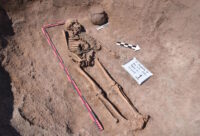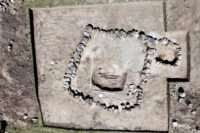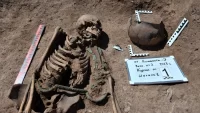 A rescue archaeology excavation at the site of railroad expansion in the Askizsky region of Khakassia in Siberia has unearthed the grave of a Late Bronze Age man buried wearing a “charioteer’s belt,” a flat bronze plate with two curved hooks at the end reminiscent of a yoke used to harness draft animals. This device is believed to have been used by charioteers to tie their reins to their waists so their hands were free for combat.
A rescue archaeology excavation at the site of railroad expansion in the Askizsky region of Khakassia in Siberia has unearthed the grave of a Late Bronze Age man buried wearing a “charioteer’s belt,” a flat bronze plate with two curved hooks at the end reminiscent of a yoke used to harness draft animals. This device is believed to have been used by charioteers to tie their reins to their waists so their hands were free for combat.
 The tomb is dated to between the 11th and the 8th century B.C., a time when the Lugav culture was dominant in the area. The site under excavation contains material remains of a cemetery as well as a settlement from this period, and the Lugav barrows in the cemetery can be grouped into three stages — the transition to the Lugav culture, the Lugav middle stage and the late stage, when characteristics from the next culture (Tagar) appear mingled with the Lugav features. The charioteer’s tomb is from the middle stage.
The tomb is dated to between the 11th and the 8th century B.C., a time when the Lugav culture was dominant in the area. The site under excavation contains material remains of a cemetery as well as a settlement from this period, and the Lugav barrows in the cemetery can be grouped into three stages — the transition to the Lugav culture, the Lugav middle stage and the late stage, when characteristics from the next culture (Tagar) appear mingled with the Lugav features. The charioteer’s tomb is from the middle stage.
It is a square masonry tomb with an earthen mound built on top of it. The deceased was buried with a bronze knife, bronze jewelry, including a necklace with rectangular pendants typical of Lugav culture, and the belt.
 Aleksey Timoshchenko, an archaeologist at the Institute of Archaeology and Ethnography of the Russian Academy of Sciences, told Live Science in an email that the object was found in its original placement at the waist of the person in the undisturbed grave.
Aleksey Timoshchenko, an archaeologist at the Institute of Archaeology and Ethnography of the Russian Academy of Sciences, told Live Science in an email that the object was found in its original placement at the waist of the person in the undisturbed grave.
“This fact, along with direct analogies in burial mounds of China, allows us to determine their purpose a little more confidently,” he said.
 No chariot remains have been found in Siberian burials from this era, and for years the hooked bronze belt was classified by Russian archaeologists as an unknown object. Its use was identified by comparison with artifacts found in Chinese chariot burials and bronzes from the Zhou Dynasty (11th-3rd century B.C.).
No chariot remains have been found in Siberian burials from this era, and for years the hooked bronze belt was classified by Russian archaeologists as an unknown object. Its use was identified by comparison with artifacts found in Chinese chariot burials and bronzes from the Zhou Dynasty (11th-3rd century B.C.).
* This article was originally published here


Aleksey Timoshchenko, an archaeologist at the Institute of Archaeology and Ethnography of the Russian Academy of Sciences, told Live Science in an email that the object was found in its original placement at the waist of the person in the undisturbed grave.










No comments:
Post a Comment